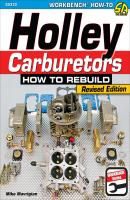Holley Carburetors. Mike Mavrigian
Чтение книги онлайн.

Читать онлайн книгу Holley Carburetors - Mike Mavrigian страница 9
Название: Holley Carburetors
Автор: Mike Mavrigian
Издательство: Ingram
Жанр: Сделай Сам
isbn: 9781613253144
isbn:
The 4160 includes a single fuel inlet with a transfer tube that feeds the vacuum-operated secondaries and a secondary metering plate rather than a secondary metering block. The metering plate is non-adjustable and has no replaceable jets. A power valve and an accelerator pump are located on the primary side only. The 4160 carburetors are the less-expensive versions of the 4150s but can be upgraded easily to 4150 status by installing a secondary bowl and metering block kit.
Series 4150
The 4150 carburetors are similar to 4160 carbs; their primary difference lies with secondary operation. The 4150 is enhanced with features such as dual fuel inlets, vacuum or mechanical secondary operation, metering blocks (with replaceable jets) on both the primary and secondary sides, and a power valve on both the primary and secondary sides. The 4150 series offers a much wider range of CFM sizes compared to the more “basic” 4160.
Series 4500
Famously known as the “Dominator” series, the 4500 is the big boy on the block. Notable differences between the 4150 series and the 4500 series are the larger 2.00-inch bores, a secondary throttle linkage that runs internally, throttle-shaft openings sealed to prevent contamination, and the elimination of an air horn/air choke to control air entry. The Dominator series has a larger bolt pattern for intake manifold mounting. Although adapters are available to mount a 4500 carb onto a 4150 intake manifold, the proper choice is a manifold that is designed to operate with a 4500-series carburetor. Dominators are good choices for engines producing more than 625 hp.
Series 4165
This series is known as a Double Pumper because it features mechanical secondaries, an accelerator pump at both bowls, and a metering block with jets at both primary and secondary sides. It has a square bore pattern.
Series 4175
These carburetors have a spread-bore base and are designed as a direct replacement for the GM Quadrajet. Series 4175 carbs have electric chokes and a single fuel inlet.
Series 4010
These carbs have a square bore with either mechanical or vacuum secondaries.
Series 4011
This series is essentially the same as a 4010, but is designed for spread-bore intake manifolds. It is offered with either mechanical or vacuum secondary operation.
Series 4224
Built as a 660-cfm drag racing carb, this carb has a center-squirter design that squirts fuel into all four barrels at the same time, aided by a hefty 50-cc accelerator pump.
The 4150 and 4160 bolt spacing, from front to rear measures 5⅝ inches.
Dominator bolt spacing, from left to right, is specified at 5⅝ inches.
Dominator bolt spacing, from front to rear, is specified at 5⅝ inches.
The 4150/4160 series requires a 5⅛-inch air cleaner/gasket; the larger Dominator requires a 7
Air Cleaner Threads
Most Holley carbs, including the 4150/4160 series, have a 1/4-20 threaded center hole to accept an air cleaner stud. The Dominator (4500) series has a larger 5/16-18 threaded hole. Inexpensive male/female adapters are readily available from any performance retailer to allow the use of either stud size. Adapters are available with 1/4-20 male thread and 5/16-18 female thread as well as 5/16-18 male thread and 1/4-20 female thread.
Holley 4-barrel carburetors are dual-stage, downdraft units. A dual-stage carb has a primary side that supplies the air/fuel mixture throughout the entire stage of engine operation, and a secondary side that operates only when the engine demands a greater quantity of air and fuel.
The basic components include a main body, baseplate (or “throttle body”), primary and secondary fuel bowls fitted with adjustable floats, accelerator pump and accelerator pump nozzle (or “squirter”) on the primary bowl, primary and booster venturi with primary discharge nozzle, throttle plates, idle fuel passage, and a primary metering block with screw-in jets on the primary side. The 4150 series has a secondary metering block; the 4160 has a secondary metering plate. The 4150s with mechanical secondary operation have an accelerator pump and squirter on the secondary bowl.
The venturi (or “barrel”) passage has a double-taper design: The larger area at the top narrows and then enlarges above the throttle plate. This shape creates higher velocity and lower pressure at the narrow section; the vacuum effect draws in fuel and air.
The fuel mixture is pre-atomized, mixing with air from the small air-bleed orifices in the top of the main body as it passes through the discharge nozzle in the venturi booster. It is emulsified further as it passes through the high-speed column of air, resulting in the air/fuel mix to change the fuel stream into tiny droplets in a “mist” configuration. The air bleeds are sized to work in conjunction with the vacuum effect in the venturi (called the venturi effect), which increases as the throttle is opened and is greatest at wide-open throttle (WOT). The venturi and booster venturi work together; the booster venturi aids in generating additional pressure drop at reduced air speed and increasing the fuel flow.
This Holley 4-barrel carb 4150 (PN 4779) is disassembled into its basic components. This carb has mechanical secondaries and a manual choke. At the bottom center is the baseplate, also called the throttle body. At the top center is the main body. The primary fuel bowl and metering block are at the right and the secondary fuel bowl and metering block are at the left.
This is a baseplate СКАЧАТЬ